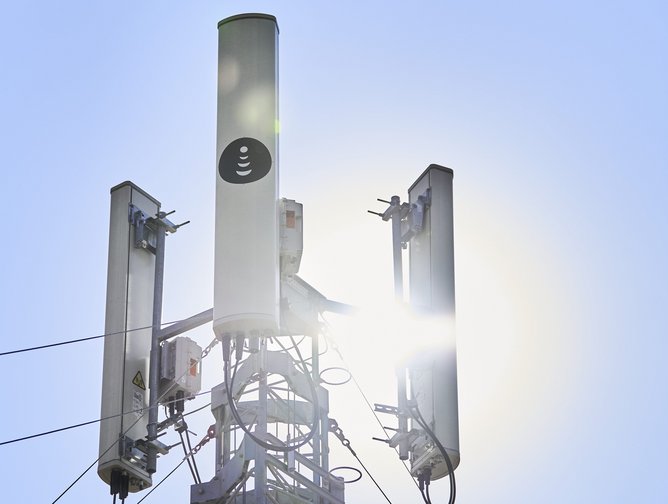DISH: Taking over the US’ Wireless Market with Open-RAN Tech
According to Statista, in 2021, the number of mobile devices operating worldwide stood close to 15 billion. With the global population at almost 8 billion, that’s nearly two mobile phones for every person on the planet. It’s therefore no hyperbole to say that, in telecommunications terms, we are truly interconnected – and that’s just through mobile phones alone.
Throughout day-to-day life, we make use of a myriad of devices to communicate without even considering the nature of their connectivity and functionality; as such, the vast majority of people are similarly unaware of the seismic technological shifts occurring beneath the surface of every industry.
Industry 4.0 and the 5G revolution have begun to coalesce, set to transform the very socio-technological fabric of our world – and the magnitude of change is creating an interesting playing field for those businesses at the forefront.
The aptly-named DISH Network (Digital Sky Highway Network) is one of the major players in this competitive field. Foreseeing the value and opportunities in dominating the wireless network – or the Digital Sky Highway – DISH firmly ensconced itself within the possibility-laden world of 5G before it was fashionable, envisioning solutions that sat outside of the box.
Over a decade ago, Charlie Ergen, the Chairman and Co-Founder of DISH Network, had the foresight to realise that the satellite TV business was (at some point) going to be a business in decline. So, he started acquiring spectrum.
“If I go back eight years ago, nobody – admittedly, including myself – ever believed that Charlie would actually build a wireless network”, added Dave Mayo, EVP of Network Development at DISH Wireless. “That was until he really inserted himself in the middle of the T-Mobile-Sprint transaction and, frankly, created a pretty magnificent opportunity for the business to create a 5G network.”
The right mix of ingenuity
In order to successfully change the wireless business model and create something new, Ergen put together a team of highly-skilled, multi-talented professionals, who could adapt to the technology’s expansive, ever-changing needs - Stephen Bye, Dave Mayo and Marc Rouanne.
Stephen Bye’s, EVP and Chief Commercial Officer, role encompasses the sales, marketing and commercial strategy aspects of DISH Wireless.
Mayo also leads a number of teams, including the US network development team that covers four regions and 36 markets, a systems integration team, a radio engineering and design team, and a network engineering and operations team. And in his role, Mayo integrates and develops the network according to provided specifications.
“Marc comes up with ideas concerning the tech, and my job is to implement them” adds Mayo, summing up the crux of his job description.
“I'm a technology guy,” agrees Marc Rouanne, EVP and Chief Network Officer. “My job concerns thinking about what technology we should consume and how we should put it together.”
One such pivotal piece of technology is the DISH 5G network, which is cloud-native and operates on an Open-RAN-based infrastructure. This is almost diametrically opposed to those of traditional operators – helping to establish DISH and its network as a one-of-a-kind solution.
Changing the status quo
As the technological landscape evolves, a number of little-known developments are permeating the technosphere, one of these being Open Radio Access Network (O-RAN).
Stephen Bye – who, in his role of CCO, is used to translating techno-speak – explains the concept further: “to understand O-RAN, you need to understand that the most critical word in that acronym is ‘open’. This ‘openness’ allows us to virtually ‘open up’ the ecosystem and separate the software from the hardware.”
The DISH team has taken the open approach to its network architecture. With O-RAN, the DISH 5G network runs on fully-virtualised - and typically containerised - software, deployed via the cloud across its network platform.
“This means that we're not encumbered or constrained by a traditional, vertically-integrated system where the software is anchored to the hardware; we no longer have those limitations”, Bye adds.
Pointing out what's exciting about O-RAN network architecture, Bye explains that it allows DISH to utilise the innovation of other parties on the platform. This essentially gives DISH the opportunity to bring in innovative software and solutions at a faster pace than legacy networks.
“We can control how that innovation works, as well as how the software is deployed in a traditional model. It’s like turning a vertical network on its side and making it horizontal”, says Bye.
In a recent conversation, Marc Rouanne outlined how DISH is currently focusing on consuming the access in a software-driven manner, which includes the mixing of traffic, having private networks and new forms of mobility services, and establishing new forms of device consumption capabilities.
“From a technology perspective, we are going to be what we call 'a network of networks'. A large part of that is going to be giving consumers - with very different, very competitive capabilities - a competitive offer, with the agility to have new and extremely fast services,” said Rouanne.
Alongside this, technological developments are driving a much faster life-cycle of software development and deployment.
“We are starting to see a much faster life-cycle wherever we are purely cloud-native”, says Rouanne.
“And this is just the beginning. It's a journey, but the beauty is that it's hard for our competitors to even get there, which gives us a playground for quite a few years that we are really going to enjoy.”
Such an ambitious project could not, of course, be achieved without the right partners. Just as everything is becoming more connected in the macro technological world, the way that businesses are operating is also reflecting this trend on the micro-scale.
DISH has a number of huge names in its partner ecosystem. These include AWS, Cisco, NOKIA, IBM, Dell, Intel and Oracle, just to name a few.
DISH interacts with these partners in the cloud, making data sharing, connection, synthesis and collaboration as easy as possible.
For Rouanne, this network of partnerships is one of DISH’s greatest successes.
“From a technology perspective, this is the biggest achievement [in networking] we have had in the last two to three years – the creation of an ecosystem that is investing in the same vision that we have.”
“The reason why our partners are massively investing is that they're convinced of what we are doing and that it's a game changer.”
Mobility and Milestones
The physical buildout of the DISH 5G network, led by Dave Mayo, has come to life in an unprecedented amount of time.
A major milestone for the company was reached in June 2022, when DISH announced that its newly built 5G network was deployed and commercially available to more than 20% of the US population, through its Project Genesis brand. This was achieved in a build of just 14 months - a feat which has never been achieved before.
The service is now commercially available across more than 120 markets and customers can purchase the DISH service and phones throughout the US.
In addition to supporting those customers, DISH will also be launching other services under different brands on its network.
Consistently affirming its reputation for quality and innovation, DISH has introduced a number of pioneering connectivity solutions to the American market. These include its Project Genesis, for which DISH launched the United States’ first cloud-native Smart 5G network, and Boost Mobile, which provides best-in-class value and connectivity to American wireless consumers, through DISH Wireless’ largest retail wireless brand.
DISH has already launched a mobile service in Las Vegas that uses VoNR (Voice Over New Radio). Remarkably, DISH is the first operator in North America to actually deploy commercial services with VoNR, which it launched back in May of 2022.
In addition to the US Federal Communications Commission (FCC) build requirements, DISH has also established roaming agreements with two network service providers.
“These really give us the opportunity to have an immediate, nationwide footprint,” comments Mayo.
Once the DISH 5G network covers at least 75% of each economic area within the United States in June 2025, DISH will have reached its final milestone, mandated by the FCC, to move on to the next phase of its expansion. This next milestone step is mandated for June 2025 (by the Federal Communications Commission). “Frankly, beyond that, we'll build things as and when they make financial sense”, Mayo adds.
The combination of roaming agreements, while building out its own network in key markets nationwide, is a clever, efficient way of operating. In an age of digital transformation, many companies are going all-in on their infrastructure at once without the business case to support it – and that can be fatal for businesses. It’s better to build up gradually and create the waves needed to justify further growth, as Mayo establishes.
“We think we'll reach what constitutes ‘critical mass’ sometime next year, approximately covering a 230-240 million population area.”
Entering the enterprise market - the next phase for DISH
The next step in DISH’s wireless expansion plans is branching into the enterprise market. And, while DISH has only just started to embark on this project - and is still looking to break into the market proper - the future prospects look hugely promising.
Bye explains that DISH sees enterprise as an enormous opportunity, and the numbers in question are not insignificant. “Today when you look at the wireless market, it represents about $US280bn of revenue, but it's dominated by consumer services and consumer rate plans, unlimited plans, SIM cards and smartphones.”
“We at DISH actually look at the market very differently. When I look at the enterprise market today, companies in the United States are spending nearly US$1tn dollars a year on services, and that covers everything from communication to software.”
The market is three to four times bigger than the wireless market alone, and wireless service providers are capturing a very small share of that – which businesses are spending on technology and services. “So, when we look at the enterprise market,” says Bye.
“Enterprise customers are looking for how they can take advantage of technology and networks to drive their efficiency, to improve their profitability and to drive productivity into their enterprise.”
As such, the question becomes, how can DISH’s wireless network and connectivity be used to achieve these objectives?
“We see our network and the platform that we're building, as becoming part of the fabric of that business. We think of it as part of its actual nervous system, which will enable that business to grow to achieve its objectives, while we can be a partner and a solution to the problems that they're facing”, explains Bye.
Many of DISH’s offerings will focus on enterprise networks. These private networks will sit on top of SMBEs (Small Medium Businesses and Entrepreneurs), which will contain their virtual mutual policy management, allowing them to control their costs, their mobility and their security in a simplified manner.
Rouanne explains how, through the use of private networks, DISH is able to "give the keys to big enterprises", enabling them to keep the data in their own facilities and giving them a greater level of control over their data security, and their ability to offload the traffic onto their own WiFi.
When asked about DISH’s vision and objectives for the market as a whole, Mayo noted that he has noticed a desire among many companies – whether it be oil and gas refineries, or manufacturers – to keep their data on-prem.
“It's counterintuitive for the incumbents to move core network elements off-prem, out of their switches and into a manufacturing, refinery or campus-type environment. That's one of the unique things that our network is engineered and architected to do, right out of the gate: to actually provide that capability.”
And Mayo confidently says that, within the next five to ten years, DISH will be far better positioned to be able to achieve that.
"I think we'll be able to take advantage of opportunities like that and be the wireless network for CIOs, which is a tremendous opportunity for the business. It'll really give us the ability to grow lots of revenue in a way that's distinct and different to our competitors.”
These last two points are important to note, as data and its security are core concerns of companies at the moment. Being able to offer capability alongside individualised security is a key differentiator.
“Existing networks are monolithic today. Because DISH is cloud-native, however, we can have a mini-core for each enterprise and they can decide – whether they fly drones, move trucks or are engaged in retail – what they do with this. It gives them full control”, Rouanne explained.
Despite initial uncertainty regarding how successful the venture into wireless networks would be, DISH has gone from strength to strength under Charlie Ergen’s leadership.
“And so, in terms of capabilities,” grins Rouanne, “I know something big is coming our way.”




